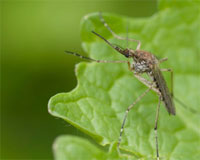
SCIENTIFIC NAME
Culicidae
DESCRIPTION
Mosquitoes are thin, long-legged, two-winged insects and are typically six to 12 millimetres in length. Both males and females have antennae and an elongated "beak" or proboscis three to four times longer than its head.
RANGE
There are thought to be 82 species of mosquitoes in Canada and over 2,500 species in the world. There are 10 main groups in Canada but only five of them have members that are significant pests of humans: Anopheles, Culex, Aedes (including Ochlerotatus), Mansonia (Coquillettidia) and a few species of Culiseta.
HABITAT
Mosquito habitat varies for each species and can include natural areas such as rain puddles and ponds, decomposing material such as wet leaf matter, ditches and marshes. While healthy wetlands are habitat for mosquitoes, they are also home to mosquito predators.
DIET
Female mosquitoes of most species need to feed on blood to develop eggs. Male mosquitoes cannot bite and both sexes of mosquitoes use their long proboscis to feed on the nectar of flowers or other sugar sources like honeydew.
BEHAVIOUR
undefinedPRIMARY ECOSYSTEM ROLES
- 0
- 1
